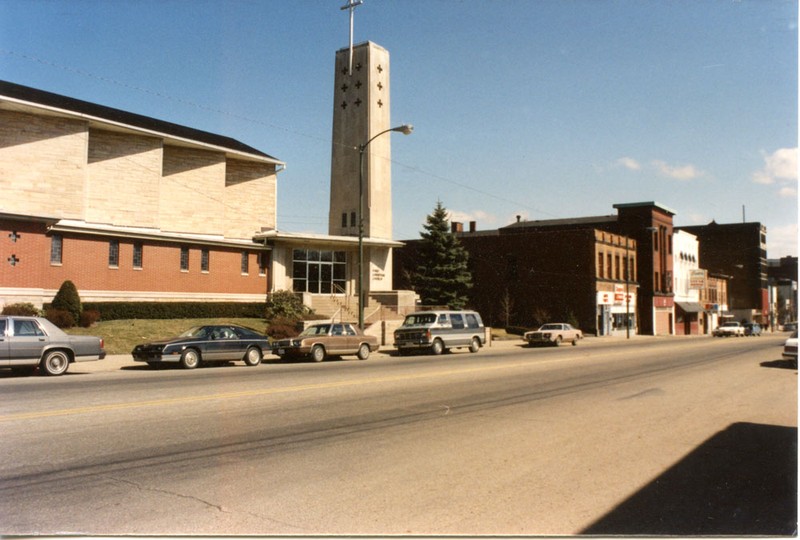First Christian Church
Introduction
Text-to-speech Audio
The complex features the 1910-11 Parsonage, 1957-58 Sanctuary, and 1968 Educational wing, each showcasing distinct architectural styles. The Colonial Revival Parsonage contrasts with the Neoclassical Educational wing. Stairs from East Main Street lead to a one-story entrance with metal and glass doors, concrete walls, and a cast concrete bell tower. Established in 1847, the First Christian Church in Alliance overcame challenges and grew, with a successful 1951 building fund drive leading to the demolition of the old sanctuary in 1957 and the completion of a new one in 1958. In the early 2000s, the congregation relocated, and in 2023, the building received the Alliance Preservation Award.
Images
First Christian Church, 1980s

Backstory and Context
Text-to-speech Audio
The complex consists of three main parts: the 1910-11 Parsonage, the 1957-58 Sanctuary, and the 1968 Educational wing. The Parsonage is in the Colonial Revival style, while the Educational wing features Neoclassical elements. The Sanctuary's first-floor facade has brick walls with cross openings and vertical windows on a stone foundation. The second story has a stone wall with four angled elongated windows. Stairs from East Main Street lead to a one-story entrance with metal and glass doors, concrete walls, and a cast concrete bell tower.
The history of the First Christian Church in Alliance dates back to 1847 when two families moved to Mt.Union and started the Disciples of Christ congregation. Mathias Hester, a key figure, was instrumental in the establishment of a church in the community. In 1857, the first permanent Christian Church was organized with 30 charter members.
Over the years, the congregation faced challenges, including doctrinal issues and a division in 1877. In 1887, the church was reorganized, and by 1897, it had outgrown its old frame building. In 1900, the congregation purchased the present property for future growth.
In the early 20th century, ministers like A. B. Way, Isaac Errett, and W. C. McCallum played significant roles. Dr. McCallum, in particular, introduced innovative Christian Education techniques. The church continued to grow, and in 1924, a new Educational Building was completed.
The church faced the challenges of two world wars and the Great Depression. In 1951, a building fund drive raised $203,000, leading to the demolition of the old sanctuary in 1957. In 1958, a new sanctuary, along with other facilities, was scheduled for completion.
In the early 2000s, the congregation left the building for a new location on Beech Street. The building was later occupied by Feed My Sheep Ministries.
In 2023, the building received the Alliance Preservation Award, awarded by the Alliance Area Preservation Society.
Cite This Entry
Historical Society, Alliance. "First Christian Church." Clio: Your Guide to History. June 11, 2024. Accessed March 31, 2025. https://theclio.com/tour/2585/3

